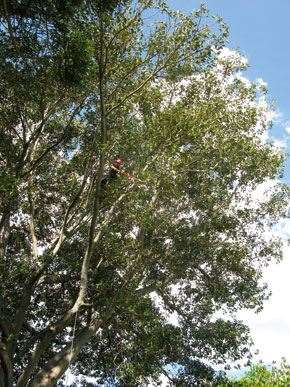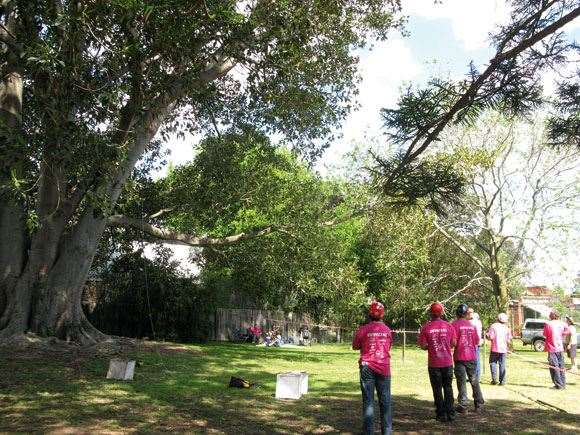Competitive tree climbers need to go out on a limb – literally – on their way to the top.
Competitive tree climbers need to go out on a limb – literally – on their way to the top
 There are no cats to rescue, just bells on branches to ring.
There are no cats to rescue, just bells on branches to ring.Images: Vanessa Murray
I’ve only been at the Victorian Tree Climbing Championship for two hours and I’m already suffering from what I’m told is a common occupational complaint: stiff neck. It’s all the looking up, because up is where the action is. The 50 or so climbers showing their stuff here today are professional arboriculturalists – that’s shop talk for tree climber. That means these aren’t just big kids who never grew up. Today’s top climbers will compete at the Australian Championships in Adelaide from May 14-19, and the first and second place-getters from the nationals will go on to represent Australia – all expenses paid – at the 2010 International Tree Climbing Champs in the US in July. Chances are it’ll be a Victorian climber at the Worlds; they’ve been leading the Aussie pack since day dot.
“The competition is based on what arborists do on a daily basis,” says Big Phil Kenyon, a former Australian champion who’s running the show. He gives me a rundown of the day’s events. There’s the Throwline, where the climber has five minutes to throw a weighted line up the tree, set a climbing rope, then scale the tree, hitting as many targets as possible to earn points. The Aerial Rescue sets up a crisis situation with a rescue dummy. The Footlock is a speed and fitness event, while the Belayed Speed Climb mixes it up a little, challenging climbers to race up the tree as fast as possible.
Then there’s the Work Climb, aka the Masters Climb. It’s the major part of the competition and it’s what we’re striding towards. It pits the top five climbers from the previous four events against each other to determine the overall winner. The climbers must scale a huge Morton Bay Fig, ring the bells using tools of the trade like handsaws and polesaws at five stations spread throughout the tree, and get back down to the ground with gear, tree and body intact.
“The Masters Climb tests their skill and agility,” says Kenyon. “It’s extremely physical, but it’s also a mental game. The climbers only have 20 minutes to get around a massive tree. If you lose the plot in those first five minutes, it’s all over.”
Climbers earn up to 300 points per climb. Points are awarded for a pre-climb safety assessment, setting the throw line and rope, ascension. Does the climber ring the bell without touching the plum bob? Are the anchor points well located and stable? Do they manage their ropes well, and manage to retrieve all their gear? How smoothly do they move through and descend the tree?Points are deducted – and disqualification risked – for safety violations, from losing your helmet, dropping equipment or having slack in your rope, to breaking branches.
Current Australian men’s champion, Grant Cody, shows us how it’s done. At one point he’s forced to make a “redirect”; he’s gone out on a limb, scaling the tree’s upper branches until he’s a small dot poised high over a marker on the outer edge of the fig. He resets his ropes, then drops, descending smoothly through the tree and lands on his target limb. He reaches out to ring the bell with his hacksaw without touching the plum bob, exits the tree, retrieves his gear and finishes in first place.
 Victorian Tree Climbing Championship
Victorian Tree Climbing ChampionshipImages: Vanessa Murray
“Yeah, my strategy worked out today,” Cody says post-climb. “There are endless ways you could do this tree. Getting a good plan in place is pretty important. Some of these branches look a hell of a lot different from the top than they do from down here.”
Cody is consistently good, says Tom Greenwood, a veteran climber and one of today’s judges. “He gets off the ground quickly and gives himself time up the tree. He doesn’t get flustered easy. If something goes wrong, he sorts it out.”The climbers work and train together; this isn’t something you do solo. And like the climbers, the gear has got to be tough. Gloves are optional, but sturdy climbing boots, helmets, harnesses, safety ropes and protective eye goggles are a must. Every climber has a kit bag; collapsible cubes containing internationally accredited tools of the trade. It’s life support – and worth a small fortune.
The trees are beautiful, but formidable. Scratches mark the climbers’ forearms; they’re covered in dust and dirt. A strong, lean body with good core strength works best; it’s 50 percent strength, 50 percent technique, one old-timer tells me. Another turns my preteen memories of tree climbing upside down when he tells me that going up is the hard part, coming down is easy. Child’s play this isn’t: our trees are in good hands.
– Vanessa Murray
Related Articles

Geitz helping the NextGen

Geitz calls time on her Diamonds career













